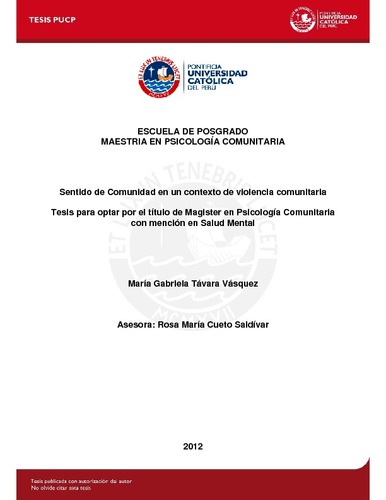| dc.contributor.advisor | Cueto Saldivar, Rosa María Luisa Martina | |
| dc.contributor.author | Távara Vásquez, María Gabriela | es_ES |
| dc.date.accessioned | 2012-12-12T19:54:45Z | es_ES |
| dc.date.available | 2012-12-12T19:54:45Z | es_ES |
| dc.date.created | 2012 | es_ES |
| dc.date.issued | 2012-12-12 | es_ES |
| dc.identifier.uri | http://hdl.handle.net/20.500.12404/1651 | |
| dc.description.abstract | El siguiente estudio analiza cómo es el sentido de comunidad, de un grupo de personas que
viven en un asentamiento humano en un distrito del cono este de Lima, en el cual se dan
procesos de violencia comunitaria. Para este fin se ha optado por una metodología mixta con
un diseño en paralelo, aplicando la Escala de Sentido de Comunidad, SCI-2 (Chavis, D.M., Lee,
K.S., y Acosta J.D.; 2008), un ítem para medir el nivel de peligro percibido a través de una
escala likert, y cinco entrevistas individuales a los pobladores. Los resultados muestran que
mientras mayor peligro se perciba en la zona, menor es el sentido de comunidad. Así mismo,
se observa que en este grupo de personas el sentido de comunidad se apoya sobre todo en la
conexión emocional compartida y el fuerte sentimiento de membresía. Por el contrario, la
dificultad para satisfacer sus necesidades colectivas por medio de la organización, y la débil
relación que existe entre los pobladores y los dirigentes merma y deteriora el sentido de
comunidad en este grupo. | es_ES |
| dc.description.abstract | The present study analyzes the sense of community of a group of people that live in a shanty
town located in a district in the east periphery of Lima, in which there is community violence. For
this purpose a mixed method with a parallel design has been used applying the Sense of
Community Index, SCI-2 (Chavis, D.M., Lee, K.S., y Acosta J.D.; 2008), a question for
measuring the level of perceived danger, and individual interviews to the settlers. The results
show that whereas the level of perceived violence in the neighborhood increases the sense of
community decreases. Furthermore it is found that in this group of people the sense of
community is based more on the shared emotional connection and on the strong sense of
membership. Par contraire, the difficulty to fulfill collective needs through organization, and the
weak relationship between the people and the leaders, diminishes and deteriorates the sense of
community in this group. | es_ES |
| dc.description.uri | Tesis | es_ES |
| dc.language.iso | spa | es_ES |
| dc.publisher | Pontificia Universidad Católica del Perú | es_ES |
| dc.rights | Atribución-NoComercial-SinDerivadas 2.5 Perú | * |
| dc.rights | info:eu-repo/semantics/openAccess | es_ES |
| dc.rights.uri | http://creativecommons.org/licenses/by-nc-nd/2.5/pe/ | * |
| dc.subject | Psicología comunitaria | es_ES |
| dc.subject | Violencia--Aspectos sociales | es_ES |
| dc.title | Sentido de comunidad en un contexto de violencia comunitaria | es_ES |
| dc.type | info:eu-repo/semantics/masterThesis | es_ES |
| thesis.degree.name | Magíster en Psicología Comunitaria con mención en Salud Mental | es_ES |
| thesis.degree.level | Maestría | es_ES |
| thesis.degree.grantor | Pontificia Universidad Católica del Perú. Escuela de Posgrado | es_ES |
| thesis.degree.discipline | Psicología Comunitaria con mención en Salud mental | es_ES |
| renati.discipline | 313307 | es_ES |
| renati.level | https://purl.org/pe-repo/renati/level#maestro | es_ES |
| renati.type | http://purl.org/pe-repo/renati/type#tesis | es_ES |
| dc.publisher.country | PE | es_ES |
| dc.subject.ocde | https://purl.org/pe-repo/ocde/ford#5.01.00 | es_ES |






